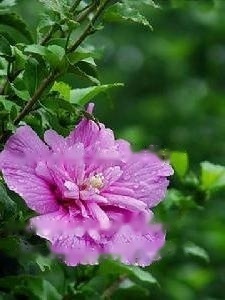
Chinese name: Hibiscus
Latin name: Hibiscus syriacus Linn.
Alternative name: Kapok, Vitex, Dawn and Twilight, Dawn
Variation: 7 Variations Name and Year: Linn., 1753
English name: Chinese rose
1. The shape of hibiscus
Hibiscus is a deciduous shrub with a height of three or four centimeters. It has small branches and is covered with yellow star-shaped fluff. The leaves are rhombic or triangular-ovate, three to ten centimeters long and two to four centimeters wide, with lobes of different shades and some without lobes. But there are three main veins, and they are very obvious. The front end is obtuse and the base is wedge-shaped. The pedicel grows between the leaf axils, the length of the pedicel is 4 to 14 mm, and the shape is short tomentose. The bracts are 6mm to 15mm long and one or two millimeters wide, densely covered with stellate sparse hairs.
2. Habits of Hibiscus
Hibiscus is mainly distributed in tropical and subtropical regions. Hibiscus species originated from the African continent. There are many species of Hibiscus in Africa, showing rich genetic diversity sex. It is native to the provinces in central China, and is cultivated in Taiwan, Fujian, Guangdong, Guangxi, Yunnan, Guizhou, Sichuan, Hunan, Hubei, Anhui, Jiangxi, Zhejiang, Jiangsu, Shandong, Hebei, Henan, Shaanxi and other provinces. Hibiscus has strong adaptability to the environment, is more resistant to dryness and barrenness, and does not have strict soil requirements. It is especially fond of light and warm and humid climates. Slightly shade-tolerant, liking warm and humid climates, pruning-resistant, heat-resistant and cold-resistant, but cultivation in northern regions requires protection for overwintering, good moisture and drought resistance, not strict soil requirements, and can grow in heavy clay soils. Tillery strong.
3. Cultivation of hibiscus
The cultivation of hibiscus can be done by sowing, layering, cuttings, ramets, etc. Before germination in early spring, the vigorously growing adult bushes are dug up. Take 3 main branches as a clump, and plant according to the plant and row spacing of 50 × 60 cm. Alternatively, it can be propagated by cuttings in spring, which will bloom in summer and autumn that year. The cutting method is as follows: after the local temperature has stabilized through 15 ℃, select 1-2 year old robust and unsprouted branches, and cut into small sections of 15-20 cm in length. When cutting, prepare a small stick, pre-insert small holes according to the spacing between the plants, and then insert the hibiscus branches, and the depth of the soil is 10-15 cm.
Guess you like it
Myrtle | Agaricus | Begonia | Fuchsia | Elderberry | Bauhinia | Grass | Thistle |
Hibiscus | Hibiscus | Periwinkle | Thousand Days Red | Pomegranate Flower |
Calendula | Five-color Plum | Onion Orchid | Morning Glory | Tuna | Hollyhock |
Daisy | Chrysanthemum | Pear Flower | Wisteria | Calla Lily | Rose | Cymbidium | Rosemary |
![[Dog Training 5] The training method of pet dog dining etiquette](/static/img/12192/12192_1.jpg)




